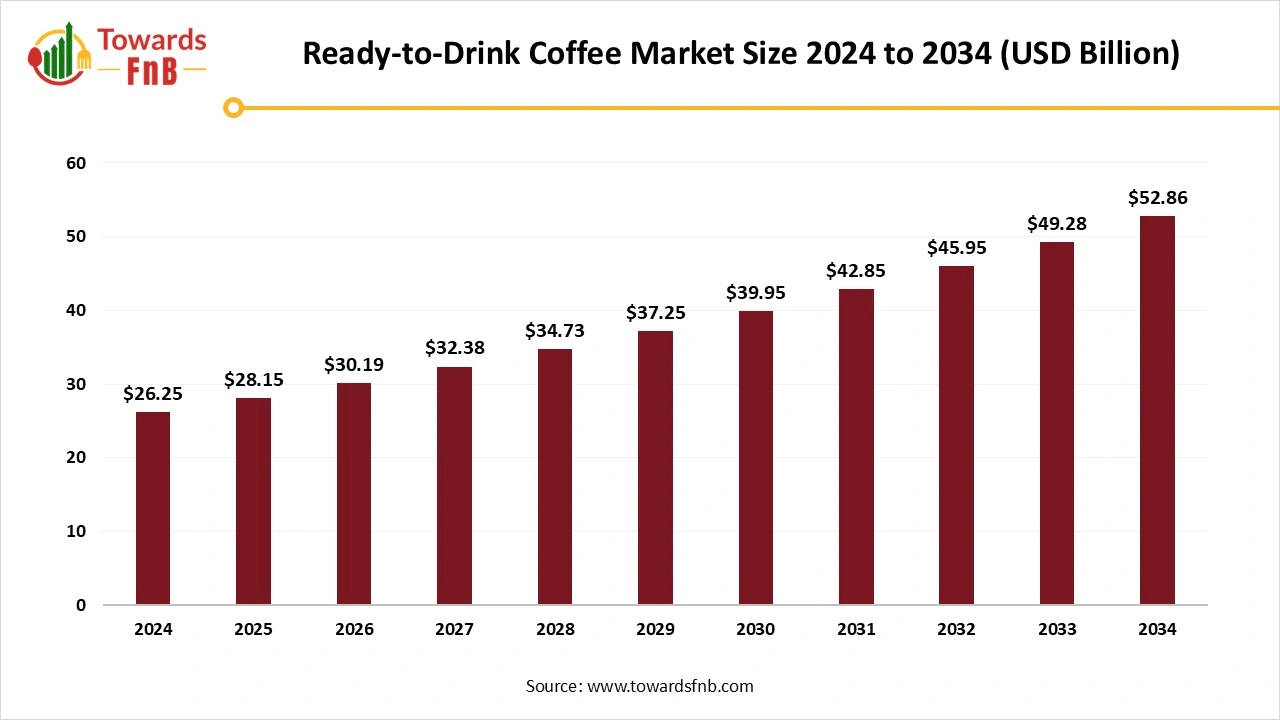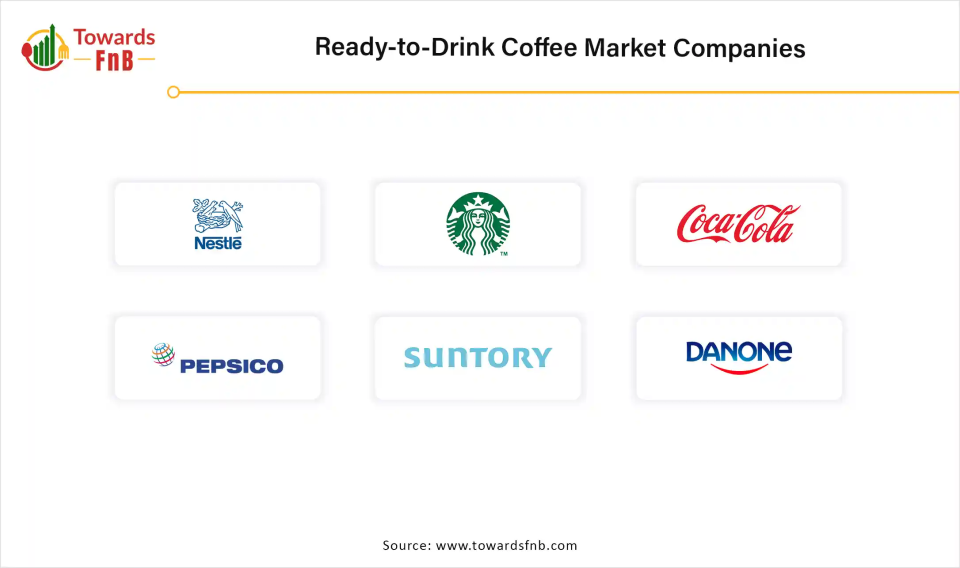January 2026
The global ready-to-drink coffee market size was valued at USD 26.25 billion in 2024 and is expected to grow steadily from USD 28.15 billion in 2025 to reach nearly USD 52.86 billion by 2034, with a CAGR of 7.25% during the forecast period from 2025 to 2034. The demand for ready-to-drink coffee is increasing due to the changing urban lifestyles, which act as a convenient option for individuals, especially working professionals.

| Study Coverage | Details |
| Growth Rate from 2025 to 2034 | CAGR of 7.25% |
| Market Size in 2025 | USD 28.15 Billion |
| Market Size in 2026 | USD 30.19 Billion |
| Market Size by 2034 | USD 52.86 Billion |
| Largest Market | Asia Pacific |
| Base Year | 2024 |
| Forecast Period | 2025 to 2034 |
| Regions Covered | North America, Europe, Asia-Pacific, Latin America, and Middle East & Africa |
The global ready-to-drink (RTD) coffee market refers to the segment of the beverage industry that offers pre-brewed and pre-packaged coffee products ready for immediate consumption, without the need for further preparation. These convenient, on-the-go coffee solutions are available in various formats like cans, bottles, and cartons, catering to the fast-paced lifestyles of modern consumers. The market's growth is propelled by factors such as increasing urbanization, busy schedules, rising demand for convenient and functional beverages, and a growing preference for cold coffee options, particularly among younger demographics. Continuous innovation in flavors, ingredients (including plant-based and functional additives), and sustainable packaging further contributes to its expansion, making it a dynamic and competitive landscape within the global coffee industry.
The rising caffeine consumption among Gen Z and Millennials is one of the major drivers that has been attracting a significant business scope for emerging companies in the convenience-based beverages sector. The ready-to-drink (RTD) coffee market is excelling massively as these generations are making coffee a part of their lifestyle. Additionally, the rising sport-oriented population in this generation plays a crucial role in attracting revenue by providing new and constant innovation in these products.
The rising health conditions like obesity, diabetes and many others are playing an influential role in reducing the use of sugar in various foods and beverages. The World Health Organization (WHO) data says that about 830 million people worldwide have diabetes, and most of these individuals are from low or middle-class families. The rise of social media is also playing a crucial role in educating consumers about excessive sugar consumption. The companies are focusing on adding clean label products that are no-sugar or zero-sugar. Additionally, the companies are investing heavily in finding sugar alternatives that will help them attract more consumers in the future. (Source: World Health Organization)
Many countries in the Asian and African regions still have a significant influence of tea from past decades, which may present certain challenges in introducing new coffee-based beverages. The lower purchasing power may also affect the growth of the ready-to-drink (RTD) coffee market, as consumers tend to spend less on packaged foods and beverages. The lower demand may also reduce product availability in these areas.
What Made Asia Pacific the Dominant Region in Ready to Ready-to-Drink Coffee Market?
Asia Pacific generated the highest revenue share in 2024 and is expected to be the fastest-growing region in the coming years. The dominance of the segment is attributed to the higher number of the youth population, which helps in providing business opportunities for the established players and the startups, too. The ready-to-drink (RTD) coffee market is expected to gain significant popularity as the developing areas in countries like China, South Korea, Japan, and India are adopting coffee consumption as a daily part of their routine. The United Nations data states that in 2025, Asia is projected to have a large youth population, with over 750 million individuals aged 15-24, representing over 60% of the world's youth population. (Source: United Nation-Youth)
Japan Ready-to-Drink Coffee Market Trends
Japan stands as a prominent player in the ready-to-drink (RTD) coffee market due to its wider cultural dominance of these beverages. The country is considered to be the home of this beverage, where canned coffee is highly popular. Additionally, the country has an established manufacturing and distribution infrastructure, which helps it to secure a dominant position in the Asian business landscape. Moreover, the rising per capita spending in the country is also expected to increase the accessibility of these products. Some statistics state that, there are 5,520,000 vending machines available in Japan, in which in every 23 people there is 1 vending machine in the country. (Source: OOMI)
North America is expected to mark a significant share during the projected period of 2025 to 2034. The growth of the region is attributed to the higher coffee culture influence in countries like Canada, the U.S. and Mexico. The ready-to-drink (RTD) coffee market is experiencing massive demand due to the rising fast-paced lifestyle influence. Additionally, the region has a higher social media influence among the youths and adults, which helps in attracting the majority of the revenue through online distribution channels. The rising health consciousness among individuals is also expected to promote the use of healthier beverages.
U.S. Ready-to-Drink Coffee Market Trends
The American consumers are highly aware of the benefits of coffee, which makes it a part of their daily routines. The higher per capita spending is also helping the companies to innovate premium and healthier products for the American consumers. Additionally, the country has a well-established manufacturing base, which helps in introducing premium products at affordable costs for the majority of consumers. The retail and vending machine culture is significantly increasing around gas stations, cafes, malls and other channels, which will expand the growth more rapidly in the future.
How did the Cold Brew Coffee Segment Dominate Ready-to-Drink (RTD) Coffee Market in 2024?
The cold brew coffee segment generated the highest revenue share in 2024. The dominance of the segment is attributed to the less bitter taste of the coffee that targets a wider population across all consumer groups. The ready-to-drink (RTD) coffee market is experiencing rapid growth as the global coffee chains like Starbucks, Blue Bottle, and others have held a major role in promoting these beverages, which is attracting innovation in the RTD market. The companies are targeting the youth population as they prefer more cold beverages due to global cultural trends. Additionally, these beverages are expected to appeal to first-time buyers, which will help in future growth.
The Functional RTD Coffee Segment is Expected to Grow at the Fastest CAGR During the Forecast Period of 2025 to 2034.
The growth of the segment is attributed to the rising shift towards health and wellness that promotes drinks that provide energy and also help in improving other aspects like immunity or fitness goals. The rising fitness trends are helping in targeting diet-conscious consumers by providing functional product lines. Moreover, trends like plant-based and clean label products are expected to boost the growth rate in the coming years.
How Were the Bottle-Based RTD Coffees Dominant in 2024?
The bottle segment marked its dominance by generating the highest revenue share in 2024. The dominance of the segment is attributed to the easy-to-carry nature of the bottles that can be helpful in on-the-go consumption. The ready-to-drink (RTD) coffee market is expanding rapidly as these products have a higher accessibility across supermarkets, vending machines, gas stations and other online channels. The companies are innovating reusable designs that can help attract a wider consumer base. Leading brands like Dunkin’, Stok, Starbucks, and others have innovated their bottle-based RTD beverages, which have helped in attracting a wider consumer base.
The Cartons Segment is Anticipated to Emerge as the Fastest-Growing Packaging Segment During the Projected Period of 2025 to 2034.
The growth of the segment is attributed to the sustainable appeal that has been gaining recognition from the regulatory bodies and governments. The ready-to-drink (RTD) coffee market will expand rapidly as these products are also lightweight, which makes them cost-effective due to the packaging. Many emerging companies are adopting these business strategies to attract a majority of the consumer base. The younger population are more environmentally oriented, which will increase the rising shift towards sustainability in the future.
How did the Dairy-Based Segment Dominate the Ready-to-Drink (RTD) Coffee Market in 2024?
The dairy-based segment stood as the dominant one by generating the highest revenue share in 2024. The dominance of the segment is attributed to the wider product availability that contains milk in its products. The ready-to-drink (RTD) coffee market is expected to grow rapidly as milk-based coffees are widely popular in all regions due to their taste. Additionally, the dairy supply chains have established partnerships with the leading industry players, which helps in attracting massive revenue. The wider product availability in mocha, caramel, flavoured coffees and others is gaining popularity among the first-time buyers.
The Plant-Based Segment is Anticipated to Grow at the Fastest CAGR During the Forecast Period of 2025 to 2034.
The growth of the segment is attributed to the rising veganism trend among consumers, which is eliminating the use of meat and dairy products. In 2024, veganism continues to grow globally, with notable increases in countries like the UK and India. Veganuary, a campaign encouraging people to try vegan, saw a record 25 million participants globally. The rapid consumer shift is also expected to help the new market startups focus on niche offerings for consumers. (Source: Veganuary)
How did the Regular Sugar Segment Dominate Ready-to-Drink (RTD) Coffee Market in 2024?
The regular sugar segment marked its dominance by contributing to the largest revenue share in 2024. The dominance of the segment is attributed to the established taste preferences among all coffee consumers. The majority of the influence is being attracted by the cafes and other commercial settings. The ready-to-drink (RTD) coffee market is expanding rapidly, as the growing demand has led to a wider product availability across all product ranges. Moreover, these sweeteners are highly popular with the dairy flavored alternatives.
The Sugar-Free Segment is Expected to be the Fastest-Growing During the Projected Period of 2025 to 2034.
The growth of the segment is attributed to the rising health awareness among consumers, which is educating consumers regarding coffee consumption. Moreover, the rising gym-going population is highly promoting sugar-free products that help individuals to increase their focus on various products. As a result, the companies are investing heavily to invest in natural sweeteners that do not compromise the taste of the sugar-free coffee beverage.
What Made the Hypermarkets/Supermarkets the Dominant the Ready-to-Drink (RTD) Coffee Market in 2024?
The hypermarkets/supermarkets segment generated the highest revenue share in 2024. The dominance of the segment is attributed to the wider presence of these stores around the developed and developing regions. These channels have a wider product range availability that promotes impulse purchases. This is significantly helping the companies to adopt multiple product offerings. Additionally, the higher shelf infrastructure segment adoption is expected to attract more demand in the coming years.
The Online Retail Segment is Expected to Grow at the Fastest CAGR From 2025 to 2034.
The growth of the segment is attributed to the growing e-grocery platforms that provide instant delivery services. The changing urban lifestyles are significantly helping the consumers to opt for convenient, home delivery purchases. The rising smartphone penetration in the developing countries is also expected to create multiple business opportunities for companies to expand their business in these areas.
Coca-Cola
Nestle

By Product Type
By Packaging
By Cream Content
By Sweetener Type
By Distribution Channel
By Region
January 2026
January 2026
January 2026
January 2026